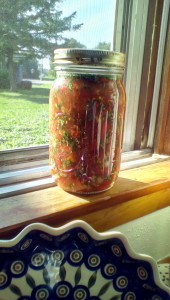I have wanted to try this recipe for a very long time. Every time I see the recipe or have a discussion about fermented foods (what, you don’t have those?) my thoughts drift to this salsa and I wonder what it tastes like. Yet, I’ve never done it, mostly because it doesn’t make sense in my head. Have you smelled rotting tomatoes? Very unpleasant. I just couldn’t see wanting to eat that smell, you know?
But this week my garden gave me an unexpected parting gift of a whole basket of fresh tomatoes. They are not the best of the season, but they were certainly unexpected. Since they were a bonus, I decided this was the time to try the lacto-fermented salsa recipe in the Nourishing Traditions cookbook by Sally Fallon. I followed the recipe precisely, except when it came to the tomatoes. I did not peel or seed the tomatoes as directed, as I never do when I make salsa. Oh, and I also eliminated the oregano. Not a big fan, and I wanted to try the salsa without it.
I mixed all the ingredients together in my quart jar, and then added a two-piece lid. Then it sat on my counter. The next day I popped the lid for just a moment- in case there was any gas in there that needed to be released. The second day I did the same- especially after I pressed down on the lid and met no resistance. That day I decided I should give the salsa a stir, since the liquid had separated out and it looked as though the salsa were floating on tqo inches of water. Today being the third day, I opened up the top and found a fine layer of white mold all over the top. A quick google search told me this was normal- as long as the mold was white and not black, brown or green, it could be removed. So I scraped off the top bit of moldy salsa, stirred the rest up, and when in for a taste.
I was very pleasantly surprised! The flavors all melded together beautifully. There is this tang in the finish that can only come from a fermented product, but it is only slightly there. The overall flavor of the salsa is simply delicious. The cilantro really comes through, as does the onion, but not in an overwhelming way at all. Andy thinks he could sit down and polish off the jar in one sitting. I popped it in the fridge to chill before we tried it with chips, and it’s even better cold. It is a touch on the salty side, as expected, but it’s not overly so. I think if you followed the direction to use extra salt instead of whey that it would be borderline inedible. It’s not hard to let a bit of yogurt strain for a few minutes to get 1/4 cup of whey, and I wholeheartedly recommend that method.
Overall it’s a surprise hit. The one thing I would change for next time would be to seed the tomatoes. I still would leave the peels on, because the peels don’t bother me, but the salsa is very, very liquidy, and I think that would be reduced some if I’d seeded the tomatoes as suggested in the first place.
Post Script: I had to come back and add just one final note for anyone looking at this salsa and having dubious thoughts like I did. I really, really, really dislike the taste of a a lot of fermenting foods. I like sauerkraut and flavored kefir and that’s about it. I dislike beer very much, and I also dislike sourdough and other breads like rye that have that distinctive yeasty-fermenting taste. This fermented salsa does not have that funky taste at all. It’s pleasant and it makes me keep going back for another bite.
Lacto-Fermented Salsa from Nourishing Traditions
4 medium tomatoes peeled, seeded and diced
2 small onion finely chopped
1/4 cup chopped chile pepper, hot or mild
1 bunch cilantro chopped
1 Tbs fresh oregano chopped
2 lemons juiced
1 Tbs sea salt
4 Tbs whey (or additional 1 Tbs salt)
1/4 cup filtered water
Directions
Mix all ingredients and place in a quart-sized, wide-mouth mason jar. Press down lightly with a wooden pounder or a meat hammer, adding more water if necessary to cover the vegetables. The top of the vegetables should be at least 1 inch below the top of the jar. Cover tightly and keep at room temperature for about 2 days before transferring to cold storage.

Whatt a material off un-ambiguity andd presedrveness oof preciouus know-how oon the topic off unxpected emotions.